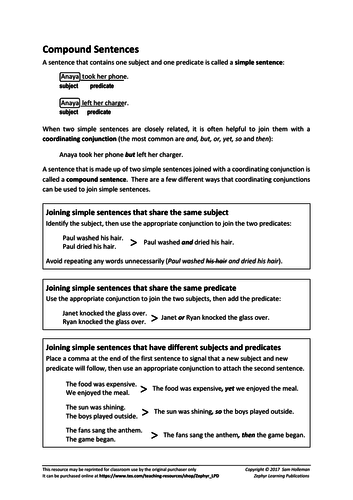





This fully resourced grammar-for-writing lesson teaches students how to use coordinating conjunctions (and, when applicable, joining commas) to combine simple sentences to form compound sentences.
*NOTE: Instead of using the American acronym FANBOYS in this lesson, I have included the more UK-appropriate ANTBOYS (most American dictionaries do not recognise 'then' as a coordinating conjunction, whereas the British council and most UK dictionaries do. Also, although 'for' is recognised as a coordinating conjunction on both sides of the Atlantic, it is almost never used in contemporary writing. As this is a grammar for writing rather than a sentence-parsing lesson, the archaic 'for' has been omitted and the British conjunction 'then' has been included, thus 'ANTBOYS'). With this in mind, teachers in North America or ESOL teachers teaching North American English may wish to hide, delete or replace the slide in the powerpoint in which I have listed the coordinating conjunctions most commonly used in the UK.
*NOTE: Instead of using the American acronym FANBOYS in this lesson, I have included the more UK-appropriate ANTBOYS (most American dictionaries do not recognise 'then' as a coordinating conjunction, whereas the British council and most UK dictionaries do. Also, although 'for' is recognised as a coordinating conjunction on both sides of the Atlantic, it is almost never used in contemporary writing. As this is a grammar for writing rather than a sentence-parsing lesson, the archaic 'for' has been omitted and the British conjunction 'then' has been included, thus 'ANTBOYS'). With this in mind, teachers in North America or ESOL teachers teaching North American English may wish to hide, delete or replace the slide in the powerpoint in which I have listed the coordinating conjunctions most commonly used in the UK.
Get this resource as part of a bundle and save up to 35%
A bundle is a package of resources grouped together to teach a particular topic, or a series of lessons, in one place.
Something went wrong, please try again later.
For the first time ever, I can finally give students a clear and definitive answer on when they should use a comma with 'and' - no more trying to judge if 'it's a long enough pause" before the and. Thanks for giving me more confidence when teaching punctuation!
Report this resourceto let us know if it violates our terms and conditions.
Our customer service team will review your report and will be in touch.
£3.00